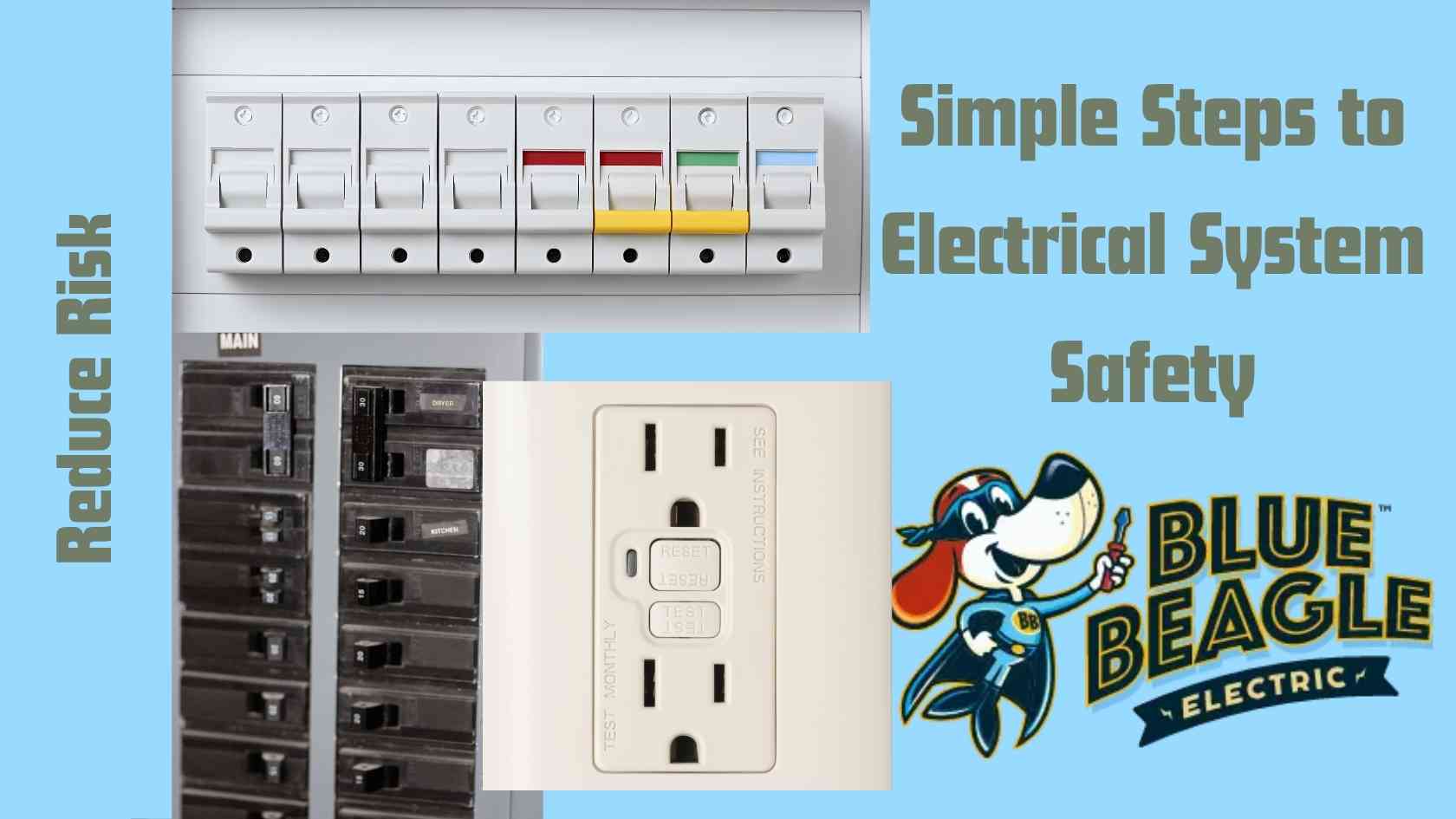
How to Reduce Electrical Risks at Home: Tips from the Pros
Electricity makes life comfortable — lights, coffee makers, phone chargers, movie nights — but it can also be one of the most dangerous things in your house if it’s not handled right. At Blue Beagle Electric, we see both sides every day. One family calls us for a routine inspection and sleeps easier knowing everything is in great shape. Another waits until a breaker is smoking or a light switch is sparking, and by then, the risks (and the repair bills) are much higher.
The good news? A few smart upgrades and habits can drastically cut your risk of shocks, fires, or costly damage. Let’s walk through some simple, practical steps that actually make a difference.
1. GFCI Protection: Safety in the Right Places
Picture this: you’re drying your hair and your kid drops a toy in the sink full of water. Without GFCI protection, that’s a dangerous situation. With it, the receptacle (also known as an outlet) cuts power in milliseconds.
Where GFCI receptacles are required in homes today:
-
Kitchen countertops
-
Bathrooms
-
Crawl spaces
-
Garages
-
Outdoors
-
Unfinished basements
What to do:
-
Walk through your home and make sure all of the above locations have GFCI receptacles installed.
-
Push the “TEST” button once a month. If it doesn’t trip, it’s time for replacement.
-
Don’t see GFCIs in these spots? Call us — we’ll get your system updated and safe.
2. Smoke & Carbon Monoxide Detectors
We’ve been on service calls where the only thing that stood between a family and disaster was a working smoke detector. These devices are simple, but they save lives.
What to do:
-
Put smoke detectors in every bedroom, outside sleeping areas, and on every floor.
-
Add carbon monoxide detectors near bedrooms and any gas appliances.
-
Test them once a month using the button.
-
Replace batteries yearly and swap the whole unit every 10 years.
If your alarms chirp constantly even after a new battery, it usually means the detector itself is past its lifespan.
3. Breakers That Match the Job
Ever had a breaker that trips every time you use the microwave and toaster together? That’s your system telling you it’s overloaded. The wrong breaker or an undersized circuit is a fire hazard waiting to happen.
What to do:
-
Breakers must always match the size of the wires they protect. (For example, 15-amp breakers for 14-gauge wire.)
-
Use AFCI breakers in living areas — they catch hidden “arc faults” that standard breakers miss.
-
Use GFCI breakers in wet or high-risk areas when receptacles aren’t enough.
-
And most importantly: use the proper brand UL-listed breaker designed for your panel. Mixing brands may look like a shortcut, but it can compromise safety.
Never “fix” a tripping breaker by installing a larger one. That’s like replacing a seatbelt with a rope — it won’t protect you when it matters.
4. Sizing Circuits: Give Your Appliances Breathing Room
Think about your kitchen and living spaces. The microwave, space heater, or even a refrigerator all pull a lot of power. If they’re crammed on one circuit, you’ll deal with constant tripping or, worse, overheated wires.
What to do:
-
Heavy hitters like EV chargers, space heaters, microwaves, HVAC systems, and dryers should each have their own dedicated circuit.
-
When you remodel or add an appliance, ask us to confirm the wiring and breakers are properly sized.
-
Always leave “room to grow” in your panel for future needs.
5. Surge Protection & Grounding: Keeping the Whole House Safe
One lightning strike in the Triangle last summer fried every TV in a Cary home we visited. A whole-home surge protector could have saved thousands.
What to do:
-
Install a whole-home surge protector at your electrical panel.
-
Use surge strips for sensitive electronics like computers and TVs.
-
Keep your grounding system healthy. A home’s grounding system provides a safe path for electricity to flow into the earth, protecting against shocks and fires by stopping stray currents from overloading your circuits. It also stabilizes voltage, reduces “electrical noise” from devices, and protects electronics from power surges — including those caused by lightning.
6. Everyday Safety Habits That Matter
You don’t need to be an electrician to make your home safer. Here are quick wins:
-
Check receptacles and switches: Warm or discolored ones are a red flag.
-
Listen: Buzzing or sizzling sounds mean trouble.
-
Look at your panel: Is it crowded or unlabeled? That’s a safety and convenience issue.
-
Ditch the daisy chains: Power strips plugged into power strips are fire hazards.
When to Call the Pros
Some fixes — like pressing the “test” button on a smoke detector — are easy for any homeowner. Others, like adding circuits or upgrading a panel, require a licensed electrician. That’s where Blue Beagle comes in. Whether you’re in Fuquay-Varina, Cary, Holly Springs, or Raleigh, our team helps homeowners feel confident that their electrical systems are safe, modern, and built to last.
A Quick Safety Checklist for Your Home
-
✅ GFCI receptacles in kitchens, bathrooms, garages, crawl spaces, outdoors, and unfinished basements
-
✅ Working smoke & CO detectors, tested monthly
-
✅ Breakers matched to wire size and panel brand
-
✅ Dedicated circuits for EV chargers, microwaves, space heaters, and large appliances
-
✅ Whole-house surge protection and a proper grounding system
-
✅ No buzzing, warm, or overloaded receptacles
Bottom line: Electricity should make life easier, not stressful. With a few smart upgrades and some regular maintenance, you can lower your risks and protect your home and family.
Ready to make your electrical system safer? Blue Beagle Electric is here to help — from inspections to panel upgrades and everything in between. Contact us online or call 919-215-6522 today to schedule a safety check with our friendly team.
